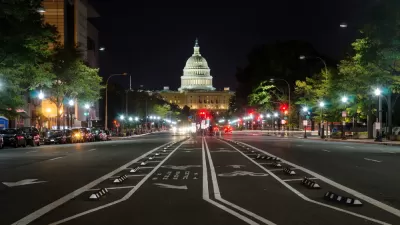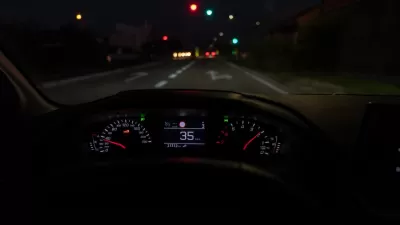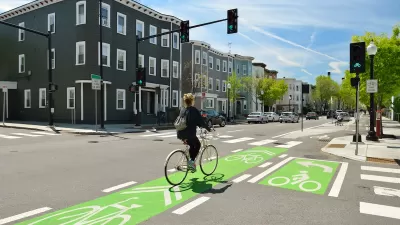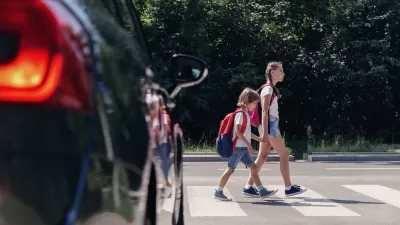The Pennsylvania Avenue Initiative seeks to redesign the capital’s most famous thoroughfare to include more park space and pedestrian amenities.

“Urban planners want to re-imagine downtown D.C.’s Pennsylvania Avenue as a signature outdoor venue, emphasizing people over cars and expanding park space between the White House and the U.S. Capitol.” As reported by Alejandro Alvarez, the Pennsylvania Avenue Initiative has proposed three potential makeovers of the famous street. “The three visions deal with different approaches to balancing pedestrian needs, recreational space and vehicle traffic, citing a 2018 D.C. transportation study that found up to 20 feet of the avenue’s current lanes could be allocated to other uses while preserving an ‘acceptable’ level of service (LOS) for vehicles.”
One plan would focus on sidewalk expansion without changing much else about existing traffic patterns. A second, “ would transform wide swathes of Pennsylvania Avenue into a curb-less pedestrian park with winding footpaths and large lawns, leaving a vestige of the roadway at its center for public transit and bike use.” The third concept would “would bisect the avenue with a mile-long central pedestrian promenade running its entire length, flanked on both sides by a combination of narrower travel and bike lanes.”
According to the article, “Planners also identified three popular public spaces along Pennsylvania Avenue, roughly correlating to the areas around Freedom Plaza, the Navy Memorial and John Marshall Park, that would be expanded under each proposal ‘to encourage a range of plaza and park-related activities with retail services and amenities.’” The Initiative’s StoryMaps site features renderings and maps of the proposed concepts.
FULL STORY: Urban planners detail 3 ways to re-imagine DC’s Pennsylvania Avenue

Alabama: Trump Terminates Settlements for Black Communities Harmed By Raw Sewage
Trump deemed the landmark civil rights agreement “illegal DEI and environmental justice policy.”

Planetizen Federal Action Tracker
A weekly monitor of how Trump’s orders and actions are impacting planners and planning in America.

Why Should We Subsidize Public Transportation?
Many public transit agencies face financial stress due to rising costs, declining fare revenue, and declining subsidies. Transit advocates must provide a strong business case for increasing public transit funding.

Understanding Road Diets
An explainer from Momentum highlights the advantages of reducing vehicle lanes in favor of more bike, transit, and pedestrian infrastructure.

New California Law Regulates Warehouse Pollution
A new law tightens building and emissions regulations for large distribution warehouses to mitigate air pollution and traffic in surrounding communities.

Phoenix Announces Opening Date for Light Rail Extension
The South Central extension will connect South Phoenix to downtown and other major hubs starting on June 7.
Urban Design for Planners 1: Software Tools
This six-course series explores essential urban design concepts using open source software and equips planners with the tools they need to participate fully in the urban design process.
Planning for Universal Design
Learn the tools for implementing Universal Design in planning regulations.
Caltrans
Smith Gee Studio
Institute for Housing and Urban Development Studies (IHS)
City of Grandview
Harvard GSD Executive Education
Toledo-Lucas County Plan Commissions
Salt Lake City
NYU Wagner Graduate School of Public Service





























